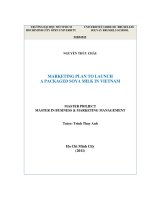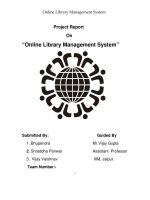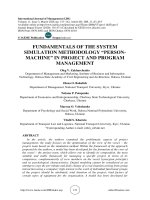final project topic restaurant management system
Bạn đang xem bản rút gọn của tài liệu. Xem và tải ngay bản đầy đủ của tài liệu tại đây (963.92 KB, 28 trang )
<span class="text_page_counter">Trang 1</span><div class="page_container" data-page="1">
<b>FINAL PROJECT </b>
<b>TOPIC: RESTAURANT MANAGEMENT SYSTEM </b>
<b>Program: Java Programming Course code: INS3035 - INS303502 Lecturer: TS. Nguyen Dang Khoa </b>
<b>Members: Kiều Văn Bách – 21070512Chu Thị Ngọc Điệp – 21070700Nguyễn Việt Hung 21070319– Nguyễn Thị Lý - 21070431</b>
<i> Ha Noi, 2023</i>
</div><span class="text_page_counter">Trang 2</span><div class="page_container" data-page="2"><b>2 Table of Contents </b>
<b>... 1 </b>
<b>CHAPTER I. INTRODUCTORY REMARKS ... 3 </b>
<b>CHAPTER II. PROBLEM STATEMENT ... 4 </b>
<b>CHAPTER IV. DESCRIBE THE DESIGN PROCESS ... 10 </b>
<b>1. Active Flow Diagram ... 10 </b>
<i><b>a. Data flow diagram ... 10 </b></i>
</div><span class="text_page_counter">Trang 3</span><div class="page_container" data-page="3">The paper delineates the problem statement concerning the development of a meal ordering system, emphasizing the growing demand for efficient and user-friendly platforms in the food sector's shift towards online services. Existing systems exhibit deficiencies that not only diminish overall user satisfaction but also contribute to operational inefficiencies. To formulate a robust and successful meal ordering solution, it is imperative to acknowledge and rectify these identified issues.
</div><span class="text_page_counter">Trang 4</span><div class="page_container" data-page="4"><b>4 1. Background </b>
A restaurant's Point of Sale (POS) system is a versatile tool that facilitates various sales tasks, including eCommerce credit card processing, eCheck payments, cash transactions, and mobile wallet payments. This advanced payment technology allows for efficient billing management, receipt printing, and easy access to company data.
The latest evolution in POS systems is the cloud-based variety, which is compatible with devices like mobile phones and tablets. Restaurants have embraced this technology, enabling them to process payments through portable devices. To grasp the similarities with ERP systems, it's helpful to understand the meaning of ERP.
In the realm of food services, the rise of online marketplaces and food delivery services has transformed the way people order food, prioritizing convenience and accessibility. This shift has created a demand for reliable meal ordering systems that offer a seamless experience for both customers and businesses.
However, current food ordering procedures face various challenges, such as complex user interfaces hindering efficient navigation, limited customization options for dietary preferences, and unreliable delivery tracking systems causing customer dissatisfaction. Restaurants struggle with managing incoming orders, communication inefficiencies, and the lack of integration with existing management systems.
Moreover, existing food ordering systems often fall short in terms of integration, scalability, and compatibility with various devices and operating systems. The lack of connectivity with third-party services like payment gateways and delivery aggregators, along with the absence of a scalable design, hampers the system's adaptability and expansion capabilities
<b>.2. Problem Statement </b>
The following can be used to construct the issue statement for the food ordering system after a comprehensive investigation of the current environment and taking into account the requirements of stakeholders:
The existing methods for ordering food, predominantly relying on manual processes such as paper-based systems, lack efficiency and hinder the overall operational flow for restaurants and food businesses. The traditional approaches, characterized by handwritten orders and manual tracking, contribute to inefficiencies, miscommunications, and delays in both order processing and delivery.
Furthermore, the reliance on outdated systems and the absence of a digital interface not only impedes customer convenience but also hampers the ability to cater to specific preferences
</div><span class="text_page_counter">Trang 5</span><div class="page_container" data-page="5">experience for customers who struggle with navigating through menus.
In addition, the current order management systems face challenges in handling incoming orders, leading to disruptions in workflow and operational inefficiencies. The inadequate communication between consumers, restaurants, and delivery personnel results in misunderstandings and delays. The absence of effective integration with restaurant management systems further complicates the order fulfillment process, causing delays and mistakes in food delivery that impact customer satisfaction and overall operational effectiveness.
Moreover, the limited integration and scalability of existing technologies restrict the accessibility of the meal ordering system. Compatibility issues with various devices and operating systems, as well as the lack of connectivity with popular third-party services like payment gateways and delivery aggregators, hinder the convenience and adaptability of the system. The absence of a scalable architecture also poses challenges in handling growing user demands and accommodating future enhancements.date future improvements is hampered by the lack of a scalable architecture.
</div><span class="text_page_counter">Trang 6</span><div class="page_container" data-page="6"><b>6 1. Introduction </b>
Our food ordering system through the POS system is a comprehensive and user-friendly platform designed to revolutionize the way consumers place food orders, aiming to enhance the overall customer experience, optimize restaurant operations, and ensure seamless integration and scalability.
A key advantage of our system lies in its straightforward and user-friendly interface, optimizing the process of ordering and menu navigation. Customers can effortlessly explore diverse menus, delve into detailed product descriptions, and view high-quality images of culinary offerings. The interface is further enhanced with intelligent search and filtering capabilities, facilitating quick discovery of desired food items. Emphasizing customization options, our system allows customers to specify dietary preferences, allergies, and special requests for a personalized ordering experience.
For restaurants and food businesses, our system provides efficient order management and organizational features. Incoming orders are seamlessly integrated into their workflow, minimizing errors and reducing the need for manual intervention. The system promotes open communication channels among customers, restaurants, and delivery personnel, ensuring smooth coordination and prompt order delivery. Integration with existing restaurant management systems is prioritized to maintain a streamlined workflow and eliminate the need for redundant data entry.
In the development of our system, we adhere to the Scrum paradigm, employing the agile Scrum approach characterized by incremental and iterative procedures. This flexible and efficient agile framework aligns with our project's goals, enhancing overall productivity. The use of Scrum allows for continuous monitoring of the workflow by all team members, facilitating quicker identification of any issues as the system undergoes testing during the sprint review.
• Product Lookup: The system may provide a capability that lets employees search for products by name or SKU (Stock Keeping Unit) code in the event that a barcode is not accessible or does not scan correctly.
</div><span class="text_page_counter">Trang 7</span><div class="page_container" data-page="7"><b>Employee management: </b>
• User Account Creation and Permissions: Using a point-of-sale system, administrators can designate distinct levels of access and authorization to individual staff members. By doing this, it is made sure that workers can only access information and features that are pertinent to their jobs and duties.
• Sales Performance Monitoring: POS systems have the ability to monitor and assess each employee's sales performance. This feature gives management insights into each worker's efficacy and productivity, enabling them to recognize top performers and offer customized coaching and rewards.
<b>Menu management: </b>
• Add dishes: You can expand the menu by adding additional dishes using the POS system. The dish's name, description, price, image, and other pertinent details can all be entered in detail. Additionally, you have the option to add a picture of your food that will appear on the menu.
• Delete an item: You can take an item out of the POS system if it is no longer available or if you wish to take it off the menu. By doing this, the item will be taken from the menu.
• Edit a dish: You can make changes to an existing dish's menu item information using the POS system. The item's name, description, price, image, and any other pertinent information can all be changed.
By utilizing these features in a POS system, businesses can streamline their operations, improve efficiency, and provide better service to their customers.
</div><span class="text_page_counter">Trang 8</span><div class="page_container" data-page="8">Ensure Integration and Scalability: The system should be developed to be responsive and compatible with various devices and operating systems, enabling users to access it from their preferred platform. Seamless integration with popular third-party services, such as payment gateways and delivery aggregators, should be prioritized to enhance convenience and expand the system's capabilities. Moreover, a scalable architecture should be designed to accommodate growing user demands and future enhancements, ensuring long-term viability and adaptability.
<b> 4. Benefits </b>
A. The intuitive and employee-friendly menu interface of our food ordering system ensures that staff can easily navigate through a diverse range of meals and make well-informed choices. With detailed descriptions and high-quality visuals, employees can visualize their desired dishes, making the ordering process efficient and enjoyable. By providing a seamless ordering experience for employees, we aim to enhance their satisfaction and encourage streamlined order processing.
B. Our food ordering system streamlines the operations of restaurants by reducing the need for a large number of employees at the rear desk. With an automated system that handles order management, communication, and coordination, restaurants can optimize their staffing resources and allocate employees to more customer-facing roles. This not only improves operational efficiency but also allows staff to focus on delivering exceptional customer service. C. By implementing our food ordering system, restaurants can benefit from significant cost savings in labor and space requirements. With fewer employees needed at the rear desk, labor costs can be reduced, contributing to overall cost optimization. Moreover, the system eliminates the need for extensive physical space to set up traditional cafeterias, particularly in areas with limited space availability. This allows restaurants to operate efficiently in compact locations and potentially expand their reach to new markets.
D. Mistakes in order processing can hurt customer satisfaction and operational efficiency. However, with our admin-controlled food ordering system, the probability of errors occurring is significantly reduced. The system is designed to enforce strict quality control measures, ensuring that orders are accurately captured, communicated, and fulfilled. This
</div><span class="text_page_counter">Trang 9</span><div class="page_container" data-page="9">requests, and contributes to a smooth and error-free order fulfillment process.
E. Our food ordering system offers customers the advantage of avoiding long queues at the counter by allowing them to execute tasks at an acceptable speed and throughput. By placing their orders through the system, customers can conveniently browse menus, customize their meals, and complete their transactions without the need for physical interaction or waiting in line. This not only improves the customer experience by saving time and effort but also helps restaurants manage peak hours and maintain an efficient flow of orders, leading to reduced wait times for all customers.
G. With a restaurant management system, creating employee schedules is simple. During busy hours, the integrated employee scheduler will automatically assign more staff members, including waiters and cashiers, and fewer during downtime. To balance supply and demand, sales data and personnel scheduling can be combined. This guarantees that your resources will always be completely utilized and won't be over or underutilized.
In summary, our food ordering system provides a clear and user-friendly menu interface, optimizes labor and space requirements, reduces the likelihood of mistakes through admin control, and enables customers to avoid long queues. By addressing these aspects, we aim to create a more efficient, cost-effective, and enjoyable food ordering experience for both customers and restaurants.
</div><span class="text_page_counter">Trang 10</span><div class="page_container" data-page="10"><b>10 1. Active Flow Diagram </b>
<b>a. Data flow diagram </b>
Login Failed: turning back to Login.
Login Succeeded: go to Restaurant Management App In Restaurant Management App have 6 sections:
1. Ordering Food: place order: Table; sellect Food Item, Quantity; Remove Item ;payment
2. Food Item Management:
Food Information: Food ID, Dish Name, Description, Price Managing Food Item: Change Picture, View, Add, Update, Delete 3. Employee Management:
Employee Information: Employee ID, Last Name, First Name, Username, Password, Phone Number, Email, Address, Date of Birth.
</div><span class="text_page_counter">Trang 11</span><div class="page_container" data-page="11">View Employee List 4. Table Management:
Table Information: Table ID, Table Name, In Service
Managing Table: View Table, Add Table, Update Table, Delete Table 5. Invoice Management:
Invoice Detail: Invoice ID, Table ID, Employee ID, Start Time, End Time, Total Amount
6. Log Out:
<b>Turning back to Log In b. Swimlane diagram </b>
</div><span class="text_page_counter">Trang 17</span><div class="page_container" data-page="17">• In the event of unsuccessful login, alert dialog an an will appear, notifying the user with the message "Invalid username or password."
</div><span class="text_page_counter">Trang 18</span><div class="page_container" data-page="18"><b>18 </b>
• If the login is successful, the application creates an instance of `RestaurantManagementApp` (assuming it's a restaurant management application) and opens a new window for the main interface. The login window is also closed prevent toreturning the login screen. to
• The list of food items is displayed on the right side of the interface, with each itemhaving an icon and a name. Users can select items from the list and add them to the cart of the selected table.
</div><span class="text_page_counter">Trang 19</span><div class="page_container" data-page="19">• Each table has a corresponding shopping cart to store selected food items. When a table is selected and food items are added to the cart, detailed information about the table and the cart is displayed in the center section of the interface.
prepared in the kitchen, the staff can make edits to the order using the RemoveButton.
</div><span class="text_page_counter">Trang 27</span><div class="page_container" data-page="27">








